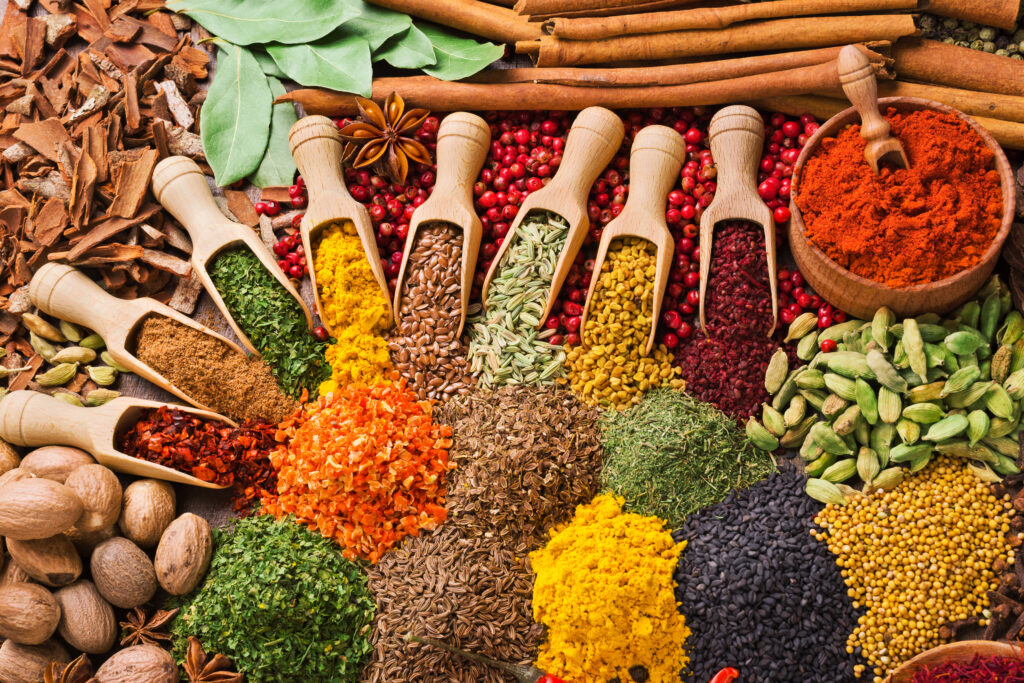Spices and herbs can add a punch of interesting flavor and aroma that will enhance your favorite everyday foods. They are also a great flavor substitute for salt, sugar, and oils. A major nutritional benefit is their ability to add a dose of antioxidants to your day. Research has shown that antioxidants are known to be powerful for fighting inflammation. Anti-inflammatory foods are known for promoting heart health! Try adding more of these five heart healthy spices to your favorite foods and recipes.
1. Cinnamon
Cinnamon is known to be a rich source of antioxidants. There are four main types of cinnamon used widely today- the most common being Ceylon cinnamon. This spice originates from the bark of a tree native to Sri Lanka. Pre-clinical research has found evidence to suggest that cinnamon is ranked at a higher antioxidant potency when compared to many other plant foods. (1) Cinnamon is great on oatmeal, yogurt, apples, baked sweet potatoes, or smoothies.
2. Turmeric
Turmeric’s most talked-about antioxidant compound is curcumin, which gives this spice its vibrant beautiful color! A clinical trial found evidence to suggest its ability to promote heart health by lowering low-density lipoproteins (LDL). (2) Lower LDL cholesterol is known to be a contributor to a healthier heart.
Studies have found that the bioactive ingredient piperine in black pepper helps to greatly enhance the absorption of curcumin. One clinical study found that curcumin’s absorption was increased by 2000% when consumed with black pepper. (3) Pair turmeric and black pepper with scrambled eggs, roasted vegetables, and soups. Add ground or grated fresh turmeric into any smoothie.
3. Oregano
Oregano is known for being used in Italian dishes, tomato sauces, and olive oil vinaigrette. This native Mediterranean herb is known to pack in a very high amount of antioxidants- especially the compounds carvacrol and thymol. Some preliminary studies have evidence to suggest oregano may help to have a beneficial impact on heart health by its power to reduce inflammation. (4) Add dried or fresh oregano to soups, grain-based salads, pesto, and marinades. Try also mixing oregano as part of a savory seasoning blend for a homemade yogurt dip!
4. Ginger
Ginger is a perennial reed-like plant native to southeastern Asia. Clinical studies have shown its effectiveness in helping to reduce nausea. (5) Pre-clinical research suggests that the antioxidants in ginger help to reduce oxidative stress and inflammation. Its most looked at bioactive component, gingerol, is of particular interest for its contribution in promoting health and helping to prevent disease. (6) Fresh or dried ginger can be added into smoothies, stir fry’s, or curries. You can also enjoy a cup of herbal ginger tea.
5. Garlic
Garlic is technically considered a root vegetable, however, we use it as a spice or herb. It grows as a bulb and is part of the allium species related to onions, shallots, and chives. We know garlic’s robust nature can amp up the flavor and aroma of our dishes. In addition to its culinary benefits, the amount of antioxidants in Garlic makes it a great heart healthy spices! Some clinical studies have evidence to suggest consuming garlic regularly may help to lower blood pressure and cholesterol, both key risk factors for heart disease. (7) You can add grated fresh garlic into homemade bean dip, chickpea hummus, or as a flavorful seasoning in roasted vegetables, soups, stews, and homemade salad dressings.
Hopefully, this information will inspire you to do more with the spices you already have at home and maybe try out a new one! There is a whole world of heart healthy spices and herbs to explore. Following a heart healthy diet can help you manage your risk and support your overall wellness. Our dietitian Lauren Burkett, MS, RDN, LD teaches us about common Heart Healthy diets!
- Boga M, Hacibekiroglu I, Kolak U. Antioxidant and anticholinesterase activities of eleven edible plants. Pharm Biol. 2011;49(3):290-295.
- Qin S, Huang L, Gong J, et al. Efficacy and safety of turmeric and curcumin in lowering blood lipid levels in patients with cardiovascular risk factors: a meta-analysis of randomized controlled trials. Nutr J. 2017;16(1):68. Published 2017 Oct 11. doi:10.1186/s12937-017-0293-y
- Prasad S, Tyagi AK, Aggarwal BB. Recent developments in delivery, bioavailability, absorption and metabolism of curcumin: the golden pigment from golden spice. Cancer Res Treat. 2014;46(1):2-18. doi:10.4143/crt.2014.46.1.2
- Singletary, Keith. (2010). Oregano: Overview of the Literature on Health Benefits. Nutrition Today. 45. 129-138. 10.1097/NT.0b013e3181dec789.
- Lete I, Allué J. The Effectiveness of Ginger in the Prevention of Nausea and Vomiting during Pregnancy and Chemotherapy. Integr Med Insights. 2016;11:11-17. Published 2016 Mar 31. doi:10.4137/IMI.S36273
- Mashhadi NS, Ghiasvand R, Askari G, Hariri M, Darvishi L, Mofid MR. Anti-oxidative and anti-inflammatory effects of ginger in health and physical activity: review of current evidence. Int J Prev Med. 2013;4(Suppl 1): S36-S42.
- Karin Ried, Garlic Lowers Blood Pressure in Hypertensive Individuals, Regulates Serum Cholesterol, and Stimulates Immunity: An Updated Meta-analysis and Review, The Journal of Nutrition, Volume 146, Issue 2, February 2016, Pages 389S–396S, https://doi.org/10.3945/jn.114.202192
